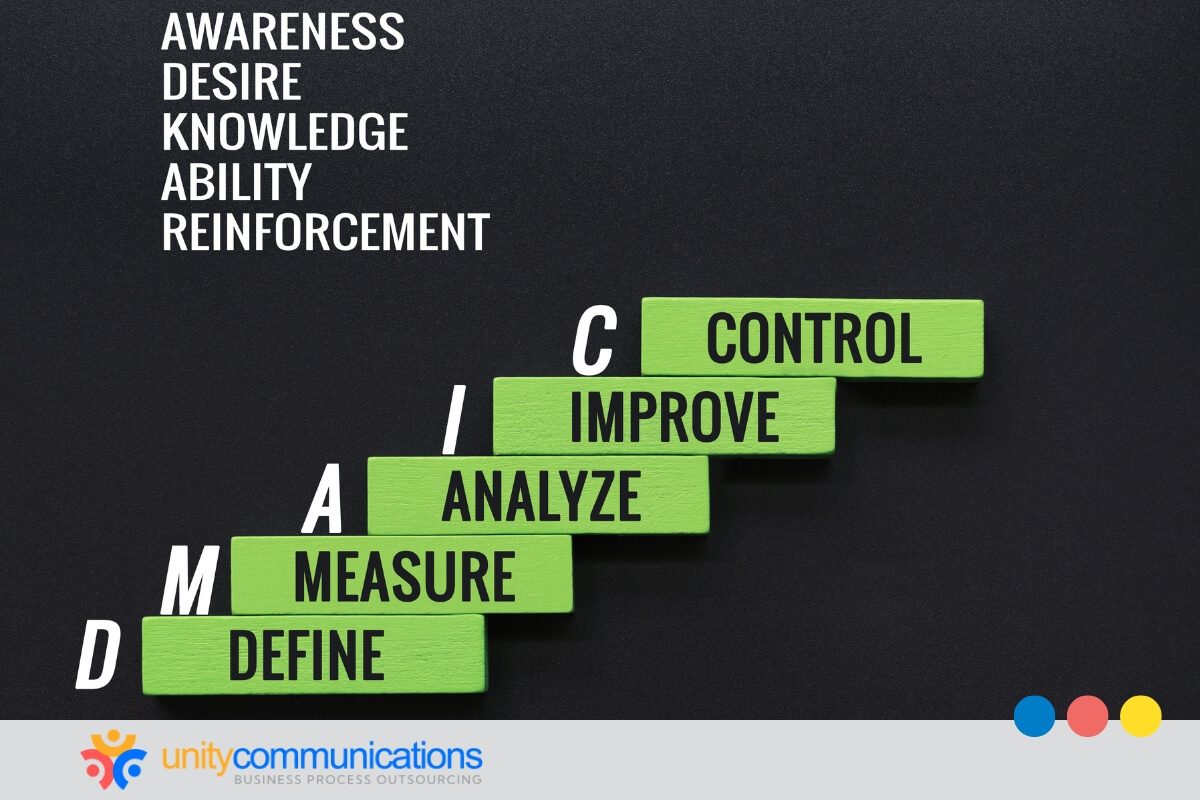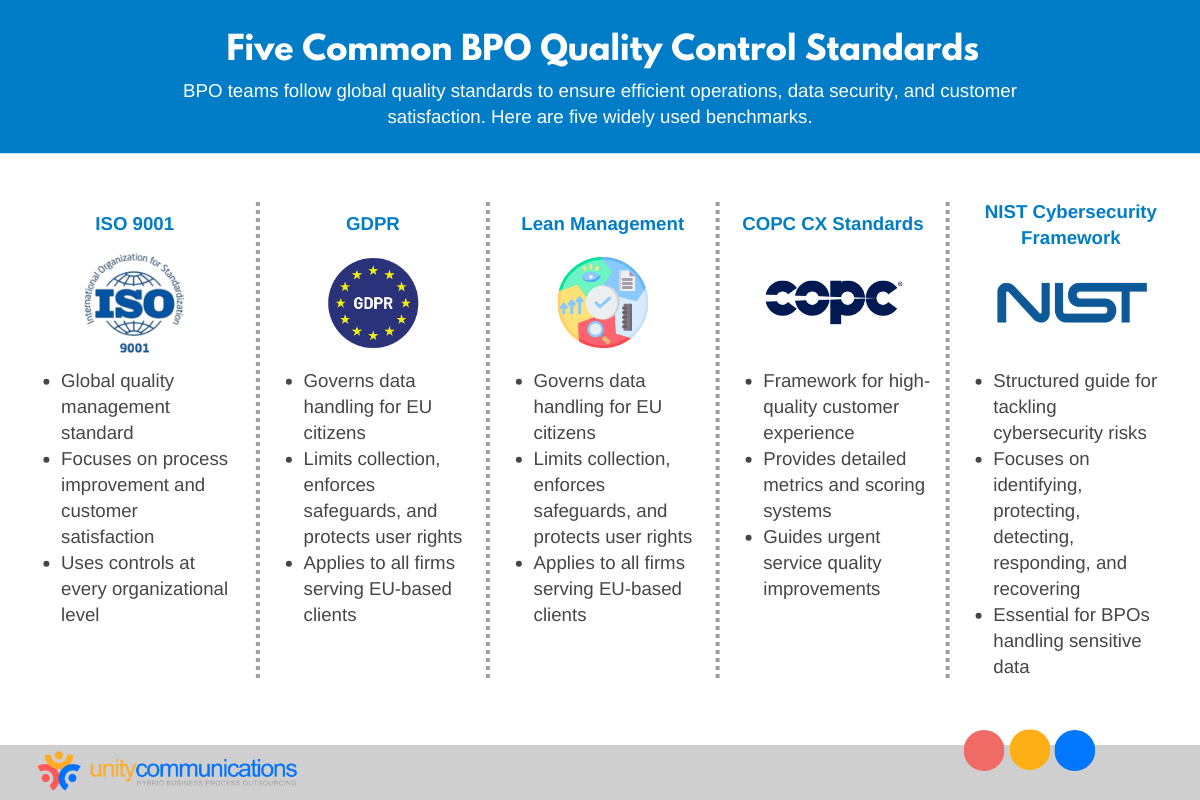Table of Contents
The core function of the business process outsourcing (BPO) industry is to provide companies with a more effective and efficient option for handling daily operations. Service-oriented roles (e.g., call center and technical support) are the most commonly outsourced, making quality a top concern.
BPO and quality control standards go hand-in-hand because clients who delegate critical jobs to BPO companies expect performance levels that match the price they pay. Quality is among the most prominent growth factors and selling points for client companies looking to outsource work.
Let’s explore the implications and consequences of quality control compliance for BPO firms.
Obtaining excellent BPO services: The role of quality control standards

It is difficult to imagine what BPO is without quality control standards attached because BPO services emphasize cost-effectiveness to some degree. That is why BPO firms strive to maintain first-rate quality standards to provide a consistent and seamless customer experience (CX).
Though reducing costs is a major motivation to outsource, client businesses understand that BPO quality control standards are central to keeping services reasonably priced and first-rate. Without it, incidents like product defects, degraded CX, or even costly lawsuits hinder the business down the line.
The following section further discusses these two main elements of BPO quality control standards.
Providing reliable BPO services
A key benefit of robust quality control compliance is that it provides a reliable and recognizable brand of quality. Methodologies like Six Sigma are integral to creating and maintaining consistency in products and services. Six Sigma follows a step-by-step process called DMAIC to assess problems:
- Define the scope, goals, and stakeholders involved.
- Measure current performance to establish baselines.
- Analyze the root cause of the inefficiencies or errors.
- Improve processes gradually to resolve problems.
- Control and maintain improvements with monitoring.
Motorola is the perfect case study of Six Sigma in action. They reduced defect frequency in their microchip production by methodically testing each variable and resolving any issues. Motorola launched three Six Sigma programs and, by 1992, aimed to have only 3.4 defects per million units.
BPO clients likewise benefit from similar quality control standards and processes because they reduce or eliminate the chance of mistakes. For instance, call centers sometimes run customer satisfaction surveys and review or listen to calls to accurately measure performance and overall service quality.
Avoiding potential legal trouble
Besides ensuring high-quality BPO services, quality control standards can mitigate the negative consequences of ineffective processes for a BPO company’s clients and customers. Delays in business processes easily translate into hundreds, if not thousands, of dollars in losses, setting up potential lawsuits.
Poor quality control also qualifies as a breach of contract if a BPO firm fails to meet the service standards established in its agreement with clients. A quality assurance (QA) expert can advise on handling sensitive data and reviewing security measures to eliminate system vulnerabilities.
Every country applies laws that affect quality control standards for local businesses. BPO firms must adhere to at least three sets of rules to maintain high quality—local laws where they operate, local laws where their clients operate, and any applicable international standards.
Five common BPO quality control standards

Over the years, companies and international organizations have crafted, applied, and circulated various methodologies. Each quality management standard and system has strengths and weaknesses, making it crucial to employ the right combination suited to an organization’s needs.
Moreover, quality assurance certifications often dictate how well organizations can successfully apply quality standards. It is not as simple as picking the most popular or effective options, but these are ideal starting points for firms seeking well-established and researched methodologies:
- International Organization for Standardization (ISO) 9001. ISO 9001 is a quality management system standard for improving processes and customer satisfaction. ISO 9001 aims to thoroughly evaluate and improve products and services by implementing controls at every level of an organization.
- General Data Protection Regulation (GDPR). The GDPR defines the proper handling of EU citizens’ data. This law limits data collection, enforces strict safeguards, and upholds users’ rights over their information. It covers all businesses serving EU-based clients.
- Lean management. Lean management principles encourage organizations to eliminate (hence, lean methodology) tasks that add little to no value to a process. Its goal is to reduce waste and optimize workflow, pushing office culture towards better efficiency and problem-solving.
- COPC CX Standards. This standard is a detailed quality management system for high-quality CX. It defines the many urgent action items in customer service quality control and includes an exhaustive assessment metric and score system.
- NIST Cybersecurity Framework. The National Institute of Standards and Technology (NIST) framework provides a well-structured guide for identifying and addressing cybersecurity challenges. This applies to all businesses, especially BPO companies that process sensitive data and provide information technology (IT)-related services.
Best practices for observing strict quality control compliance

Though all quality standards include step-by-step instructions to achieve compliance, they rarely prescribe systems or methods an organization must use. Maximizing benefits by following best practices is fundamental to solidifying quality control compliance as a core organizational feature.
Here are some key points to observe when designing or implementing quality control measures:
- Identify local and global quality standards that affect services and client operations. The U.S.’s Controlling the Assault of Non-Solicited Pornography And Marketing (CAN-SPAM) Act of 2003 and the EU’s GDPR perfectly illustrate the value of knowing and differentiating pertinent standards for outsourcing services and business processes.
- Leverage tech tools that streamline communication and improve response times. Project management apps like Slack and Monday.com keep progress remotely accessible and accurately measured at all times. They also readily convert tasks into detailed checklists.
- Produce a concise but comprehensive training module to ensure all employees are fully aware of roles and protocols in the organization’s quality control system. Visual content helps simplify concepts and standardize outputs, with handbooks acting as supplements.
- Determine risk factors that directly and indirectly affect quality control and organize them into analytic tools, such as the Failure Mode and Effect Analysis (FMEA). This provides a holistic overview of problem areas, aiding in preventative measures that maintain quality.
- Formulate a system to continuously evaluate and improve existing quality standards and management systems. Organizations like the ISO and COPC periodically update documents to ensure that recent BPO integrations (e.g., generative artificial intelligence, or gen AI) are considered.
Future trends in quality control compliance
One of the main factors affecting compliance standards for quality control is technology, with people and governments mainly focusing on concerns related to AI and cybersecurity. Increasingly smart and stable gen AI tools have also sparked major concerns over ethics and work quality.
Incidences of cyber attacks, identity theft, and data leaks have likewise raised concerns over the inadequacy of current cybersecurity protocols. The government and independent bodies have taken the initiative to improve awareness and provide training in advanced security measures.
Rapid digitalization is one way to describe how technology is changing the BPO industry, and it is likely to grow exponentially with the democratization of intelligent software as a service (SaaS) products and tools.
The bottom line

A primary selling point of BPO is the benefit of high-quality service at lower costs. Standardizing processes is essential to ensure consistent and exemplary customer service by eliminating variations and poor outcomes.
However, standardization does not equal stagnation. Given how quickly modern technological solutions and problems evolve, constant adaptation and improvement are necessary.
Let’s connect and discuss the best approach to strengthening quality control compliance for your organization’s services.




